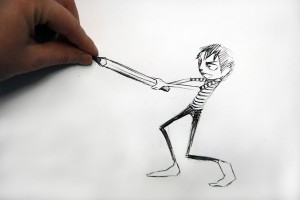Archive for the ‘Seeing Things As They Are’ Category
Of Sound Mind and Body
 As professionals we get paid to think. But unlike professional athletes, we’ve forgotten the importance of mind and body.
As professionals we get paid to think. But unlike professional athletes, we’ve forgotten the importance of mind and body.
Clearly, mind is connected to body. (I’m not talking about a metaphysical connection, I’m talking about a physical physical connection.) There are electromechanical connections (nerves) that pass information between the two and hydromechanical connections (blood vessels) that pass chemistry (oxygen and glucose, among others). The coupling is clear – what happens in one influences the other, then the other retorts. This back-and-forth ringing is complex and real. From the outside, our system architecture is highly coupled, yet from the inside we forget.
Professional athletes want high performance, and they get it through hard work, good food, regimented eating schedules, and rest. From the outside it seems they’re all about body, but on the inside they’re all whole system optimization – mind and body. (Yogi Berra – baseball is 90% mental and the other half physical.) They know food and rest influence the body, but they also know it influences the mind. They remember, we forget.
As a professional thinker, I urge you to do all you can to think well. Eat well, eat regularly, and get rest. The cost of a bad decision is high, and they’re more likely when blood sugar is low and you’re tired. If you don’t do it for your career, do it for your company – remember, they’re paying you to think.
(Image credit: iStockphoto)
When It’s Time For a New Cowpath
 Doing new things doesn’t take a long time. What takes a long time is seeing things as they are. Getting ready takes time, not doing new. Awareness of assumptions, your assumptions, others’ assumptions, the company’s – that’s critical path.
Doing new things doesn’t take a long time. What takes a long time is seeing things as they are. Getting ready takes time, not doing new. Awareness of assumptions, your assumptions, others’ assumptions, the company’s – that’s critical path.
An existing design, product, service, or process looks as it does because of assumptions made during long ago for reasons no longer relevant (if they ever were). Design elements blindly carried forward, design approaches deemed gospel, scripted service policies that no longer make sense, awkward process steps proceduralized and rev controlled – all artifacts of old, unchallenged assumptions. And as they grow roots, assumptions blossom into constraints. Fertile design space blocked, new technologies squelched, new approaches laughed out of town – all in the name of constraints founded on wilted assumptions. And the most successful assumptions have the deepest roots and create the deepest grooves of behavior.
Cows do the same thing every day. They wake up at the same time (regardless of daylight savings), get milked at the same time, and walk the same path. They walk in such a repeatable way, they make cowpaths – neat grooves walked into the landscape – curiously curved paths with pre-made decisions. No cow worth her salt walks outside the cowpath. No need. Cows like to save their energy for making milk at the expense of making decisions. If it was the right path yesterday, it’s right today.
But how to tell when old assumptions limit more than they guide? How to tell when it’s time to step out of the groove? How to tell a perfectly good cowpath from one that leads to a dry watering hole? When is it time to step back and create new history? Long ago the first cow had to make a choice, and she did. She could have gone any which way, and she did. She made the path we follow today.
With blind acceptance of assumptions, we wither into bankruptcy, and with constant second-guessing we stall progress. We must strike a balance. We must hold healthy respect for what has worked and healthy disrespect for the status-quo. We must use forked-tongue thinking to pull from both ends. In a yin-yang way, we must acknowledge how we got here, and push for new thinking to create the future.
The Bottom-Up Revolution
 The No. 1 reason initiatives are successful is support from top management. Whether it’s lean, Six Sigma, Design for Six Sigma or any program, top management support is vital. No argument. It’s easy with full support, but there’s never enough to go around.
The No. 1 reason initiatives are successful is support from top management. Whether it’s lean, Six Sigma, Design for Six Sigma or any program, top management support is vital. No argument. It’s easy with full support, but there’s never enough to go around.
But that’s the way it should be. Top management has a lot going on, much of it we don’t see: legal matters, business relationships, press conferences, the company’s future. If all programs had top management support, they would fail due to resource cannibalization. And we’d have real fodder for our favorite complaint—too many managers.
When there’s insufficient top management support, we have a choice. We can look outside and play the blame game. “This company doesn’t do anything right.” Or we can look inside and choose how we’ll do our work. It’s easy to look outside, then fabricate excuses to do nothing. It’s difficult to look inside, then create the future, especially when we’re drowning in the now. Layer on a new initiative, and frustration is natural. But it’s a choice.
We will always have more work than time….
How To Fix Product Development
 The new product development process creates more value than any other process. And because of this it’s a logical target for improvement. But it’s also the most complicated business process. No other process cuts across an organization like new product development. Improvement is difficult.
The new product development process creates more value than any other process. And because of this it’s a logical target for improvement. But it’s also the most complicated business process. No other process cuts across an organization like new product development. Improvement is difficult.
The CEO throws out the challenge – “Fix new product development.” Great idea, but not actionable. Can’t put a plan together. Don’t know the problem. Stepping back, who will lead the charge? Whose problem is it?
The goal of all projects is to solve problems. And it’s no different when fixing product development – work is informed by problems. No problem, no fix. Sure you can put together one hell of a big improvement project, but there’s no value without the right problem. There’s nothing worse than spending lots of time on the wrong problem. And it’s doubly bad with product development because while fixing the wrong problem engineers are not working on the new products. Yikes.
Problems are informed by outcomes. Make a short list of desired outcomes and show the CEO. Your list won’t be right, but it will facilitate a meaningful discussion. Listen to the input, go back and refine the list, and meet again with the CEO. There will be immense pressure to start the improvement work, but resist. Any improvement work done now will be wrong and will create momentum in the wrong direction. Don’t move until outcomes are defined.
With outcomes in hand, get the band back together. You know who they are. You’ve worked with them over the years. They’re influential and seasoned. You trust them and so does the organization. In an off-site location show them the outcomes and ask them for the problems. (To get their best thinking spend money on great food and a relaxing environment.) If they’re the right folks, they’ll say they don’t know. Then, they’ll craft the work to figure it out – to collect and analyze the data. (The first part of problem definition is problem definition.) There will be immense pressure to start the improvement work, but resist. Any work done now will be wrong. Don’t move until problems are defined.
With outcomes and problems in hand, meet with the CEO. Listen. If outcomes change, get the band back together and repeat the previous paragraph. Then set up another meeting with the CEO. Review outcomes and problems. Listen. If there’s agreement, it’s time to put a plan together. If there’s disagreement, stop. Don’t move until there’s agreement. This is where it gets sticky. It’s a battle to balance everyone’s thoughts and feelings, but that’s your challenge. No words of wisdom on than – don’t move until outcomes and problems are defined.
There’s a lot of emotion around the product development process. We argue about the right way to fix it – the right tools, training, and philosophies. But there’s no place for argument. Analyze your process and define outcomes and problems. The result will be a well informed improvement plan and alignment across the company.
Make your green programs actionable
 There’s a big push to be green. Though we want to be green, we’re not sure how to get there. We’ve got high-level metrics, but they’re not actionable. It’s time to figure out what we can change to be green.
There’s a big push to be green. Though we want to be green, we’re not sure how to get there. We’ve got high-level metrics, but they’re not actionable. It’s time to figure out what we can change to be green.
One way manufacturers can be green is to reduce their carbon footprint. That’s one level deeper than simply “being green,” but it’s not actionable either. Digging deeper, manufacturers can reduce their carbon footprint by generating less greenhouse gases, specifically carbon dioxide. Reducing carbon dioxide production is a good goal, but it’s still not actionable.
Looking deeper, carbon dioxide is the result of burning fossil fuels,
WHY, WHAT, HOW to Improve Engineering
 When asked how to improve manufacturing, the recipe is clear: lean. When asked how to improve engineering, the recipe: there isn’t one. Each engineering improvement effort is unique; though there are common themes and building blocks, each has its own fingerprint.
When asked how to improve manufacturing, the recipe is clear: lean. When asked how to improve engineering, the recipe: there isn’t one. Each engineering improvement effort is unique; though there are common themes and building blocks, each has its own fingerprint.
Each company has its own strengths, weaknesses, opportunities and threats; each company has unique products and markets; each its own goals; each its own culture; each its own future state. Informed by uniqueness, the recipe is unique. To create your unique improvement recipe, I suggest WHY, WHAT, HOW.
WHY
Before your engineering improvement recipe can be formed, the fundamental shaping question must be answered. Take a breath, fire up your laptop, put on your headphones, and queue up your best music. Type this question:
WHY does our business demand we improve engineering?
Now, type the answer. (Literally.) Use nouns and verbs to explain why engineering must improve. If you can’t, stop. Without a clear, concise, jargon-free answer nothing can be done to advance the cause. (Though there can be plenty of activity, there can be no progress.) Without the WHY, you cannot pass GO. You must create a clear, concise WHY.
Seek out help from trustworthy people to create the WHY. Don’t move forward until you understand it well enough to explain it to the engineering organization. Now, with WHY in place, it’s time for WHAT.
WHAT
Informed by WHY, it’s time for WHAT. Secure a quiet spot, scare up a big piece of paper, and grab your favorite pen. On the top of the page, write this question:
WHAT does engineering improvement look like?
Now, draw the picture. (Literally.) Use sketches, scribbles, arrows, blocks, and people’s names to describe what improved engineering looks like. Sit in the future and describe it in present tense. Once drawn, review it with folks you trust, revise it, and repeat. If you cannot draw the future, keep trying. Once you have something, review it with folks you trust, revise it, and repeat. Don’t move forward until you draw it clearly enough to explain it to the engineering organization. And with WHAT in place, it’s time for HOW.
HOW
The first step of HOW is similar to WHAT. Pick up your favorite pen, come back to the now, and draw a picture of today’s engineering capabilities, engineering’s current state. Again, use scribbles, blocks, arrows, and names.
The second step is to define the difference between future and current states. With future and current state pictures side-by-side, perform a mathematical subtraction: future state – current state. The difference is HOW. A block in future state that’s not part of the current state is a new thing that must be created; a new arrow in the future state is an activity, interaction, or relationship that must be created; a new person, named or unnamed, represents new thinking. Things that appear in both states are strengths to build on.
The third step, prioritization. Start here:
What engineering strengths will we build on?
It’s important start with strengths. It sends the right message to the engineering organization: we must build on build on what works, build on what got us here. Engineers need to know that, fundamentally, their work is good, and major building blocks are in place, the foundation is solid.
What development areas will we improve?
Take care with this one. To avoid a demoralized engineering team, there should be fewer development areas than strengths. Though there may be many development areas, call out only the most important.
What’s the right first bite?
The most important improvements are those that strongly support the WHY; there’s a natural sequence of things (socks before shoes) that must be respected; and there’s a finite amount of work that can be done. Use these three lenses as the start of a prioritization framework.
Building blocks for engineering improvement are the same for all companies: people, tools, and processes, but there are many types of people, countless engineering tools, and all processes can be improved. WHY, WHAT, HOW can help define your unique improvement fingerprint: the right people, the right tools, the right processes, shaped by your unique company goals, and improved in right sequence.
The two parts of innovation
 Innovation has two parts: ideation and commercialization. Ideation, the first part, is all about ideas, and this the part of innovation that comes to mind when we think of innovation. Commercialization, the second part, is all about products. This is the part we don’t think of, and this is the part we’ve got to do better.
Innovation has two parts: ideation and commercialization. Ideation, the first part, is all about ideas, and this the part of innovation that comes to mind when we think of innovation. Commercialization, the second part, is all about products. This is the part we don’t think of, and this is the part we’ve got to do better.
Ideation happens readily, and it happens at the whiteboard, that mystical device that can focus the universe’s creativity onto a 3 foot buy 4 foot sheet. In front of the whiteboard it’s exciting, fast, frenzied; ideas jump directly from ether to whiteboard, and we are only the unconscious conduits. With a dry erase marker in each hand and several other colors at the ready, markers fly about as if guided by a spiritual force; flow charts magically appear with all the blocks and all the right arrows; shirt sleeves are used as erasers to keep up with the flow of ideas. This is what comes to mind when we think about innovation. But this is the easy part. Fact is, we already have enough good ideas, and what we need is better execution, better commercialization.
Commercialization is a different game altogether. Once ideas are created and documented in and understandable way, the real work, the difficult work, begins. The biggest fundamental challenge is how to choose between a recently invented whiteboard idea (with no revenue stream) and a modification of something that sells today (with an existing revenue stream). Traditional net present value techniques aren’t the right answer because they always favor improvements of the existing stuff, and any ranking process must guess at future sales for the whiteboard idea, and guesses are not sufficient to carry the day. It’s a tough road, and a detour may be in order.
As advocate for the whiteboard ideas, choose the path less traveled, take the detour. Figure out where the company wants to go, understand the destination. Then, review all the non-whiteboard ideas, the improvements to existing stuff, and see if those ideas, on their own, can get the company to its new destination. It’s my bet they cannot, that there will be gaps. (But if they can, the whiteboard ideas are dead in the water.) With gaps defined, there is now a rationale, now a reason, to believe in the whiteboard ideas. Finally, some leverage.
Staring with the gap analysis, sprinkle in the best whiteboard ideas, and see what it looks like, see where the ideas could take the company. My bet is the picture looks better with the whiteboard ideas in the mix; my bet is there will now be plausible scenarios where the company can achieve its desired future state. (Plausible scenarios may not sound like much, but they’re a whole lot better than knowing you won’t make it). And once company leaders see how the whiteboard ideas improve the situation, some may get sufficiently jazzed to swap out a few more of the improve-the-old-stuff ideas for more whiteboard ideas.
It’s extremely difficult to challenge the status quo, to go head-to-head with existing revenue streams, but that’s exactly what whiteboard ideas must do. To carry the day, company leaders must say yes to whiteboard ideas at the expense of improve-the-old-stuff ideas. That’s a particularly difficult hurdle since business unit leaders are judged on hitting their numbers (thankfully). The upside of moving the company closer to its desired future state must outweigh the downside of saying no to investments in predictable revenue streams. Let’s be clear, this can only be an emotional decision.
With allocation of resources, the whiteboard idea is off and running, though not home free. It will be continually challenged by the established business units, who, at every turn, will ask to judge the whiteboard idea using improve-the-old-stuff criteria. Talk about the gap analysis where possible.
I’ve found ideation far more fun than commercialization, and commercialization far more difficult than ideation. But like peanut butter and jelly or Oreos and milk, neither has meaning without the other. We’ve got the ideation stuff down, but our execution/commercialization stuff needs serious work.
Though not glamorous, we’ve got to improve the commercialization element of innovation if we are to realize more of its benefits.
Mental Walls
 Mental walls are more powerful than physical ones.
Mental walls are more powerful than physical ones.
With physical walls you know where they start and end and know if you can bust them down. With mental walls, you’re not sure.
With physical walls you know they exist – that they’re real. With mental walls, you’re not sure.
With physical walls you can blame someone for bad workmanship. With mental walls, you’re the workman.
The only way to tell a real wall from a mental one is to to take a run at it, but even then, you’re never really sure.
Work that creates wealth
 Today’s biggest problems are difficult to solve and our approach to solving them isn’t helping. Whether it’s healthcare, education, infrastructure, defense, or the economy we never get past the wrong question: “Who’s going to pay for it?
Today’s biggest problems are difficult to solve and our approach to solving them isn’t helping. Whether it’s healthcare, education, infrastructure, defense, or the economy we never get past the wrong question: “Who’s going to pay for it?
With healthcare we argue about costs and taxes – who pays and how much. But we’ve got to move past that argument. The real deal is we create insufficient wealth. (Our inability to pay for healthcare is a symptom.) So the real solution must focus on work that creates wealth, real wealth. I’m not talking about merger and acquisition wealth. I’m talking about real wealth generated by inventing, designing, and making products. I’m talking about manufacturing – creating products out of dirt, rocks, and sticks and selling them for more than the cost to make them. With more manufacturing we can fix healthcare. (I also think we should look deeply at the work of providing healthcare and improve the work.)
With education we argue about costs and taxes – who pays and how much. But we’ve got to move past that argument. The real deal is we create insufficient wealth. (Our inability to pay for education is a symptom.) So the real solution must focus on work that creates wealth, real wealth. I’m not talking about merger and acquisition wealth. I’m talking about real wealth generated by inventing, designing, and making products. I’m talking about manufacturing — creating products. With more manufacturing we can fix education. (I also think we should look deeply at the work of providing education and improve the work.)
With infrastructure we argue about costs and taxes – who pays and how much. But we’ve got to move past that argument. The real deal is we create insufficient wealth. (Our inability to pay for infrastructure is a symptom.) So the real solution must focus on work that creates wealth, real wealth. I’m talking about real wealth generated by inventing, designing, and making products. I’m talking about manufacturing — creating products. With more manufacturing we can fix our infrastructure. (I also think we should look deeply at the work of creating and maintaining infrastructure and improve it.)
With defense we argue about costs and taxes – who pays and how much. But we’ve got to move past that argument. The real deal is we create insufficient wealth. (Our inability to pay for defense is a symptom.) So the real solution must focus on work that creates wealth, real wealth. I’m talking about manufacturing — creating products. With more manufacturing we can fix defense. (I also think we should improve the work of providing defense.)
Pulling it all together, with the economy we argue about taxes – who pays and how much. But we’ve got to move past that argument. The real deal is we create insufficient wealth. (Our economy’s health is a symptom.) So the real solution must focus on work that creates real wealth. I’m talking about manufacturing. With more manufacturing the economy will fix itself.
Thankfully we all have different views on healthcare, education, infrastructure, and defense, and I want to preserve them. (That’s what makes our country great.) However, I think we can all agree that creating more wealth will improve our chances of fixing our big problems.
Let’s do more manufacturing.
Great coaches invest.
 Great coaches invest. They’re all-in. It’s that simple. They know what you need and give it you. No need to ask. (And that’s best because often you don’t want it.) Great coaching is like medicine – tastes like crap and three years later you feel better.
Great coaches invest. They’re all-in. It’s that simple. They know what you need and give it you. No need to ask. (And that’s best because often you don’t want it.) Great coaching is like medicine – tastes like crap and three years later you feel better.
Great coaches are grounded in the reality of doing. They believe in sweat, struggle, and pain. They’re all about doing.
Great coaches don’t give options when options are not best. Sure, they know there are options, but they know they’re not for you. Great coaches take control of your best interests until you’re ready. One day at high school track practice my coach told me I was the anchor leg for the mile relay. (I didn’t know I was on the ballot.) He looked me in the eye and said – “There’s only one rule to running last – don’t let anyone pass you.” For the remaining three years of my career I never did.
Great coaches coach everyone differently. Sure they work within their framework, but the coaching is designed to fit you, not them.
Great coaches push down hard to get you to stand taller. At baseball practice one hot summer afternoon (I was sixteen) my coach had us run repeatedly on and off the field to make sure we did it right. (He believed in practicing all facets of the game.) For the first five times, or so, I ran. Most jogged, but I ran. (I always hustled.) But, on the next one I jogged. Loudly, forcefully, angrily, in front of everyone, he said, “What the hell is going on? We’ve been playing like crap lately and now our best play is jogging off the field. What the hell is going on? We’re going to do it again because he jogged.” He gave me what I needed – his medicine fit and I stood taller. (Over our six years together that was the only time he yelled about my behavior.)
Great coaches are great because they always tell the truth. Great coaches are great because they invest.
I see dead people.
 Seeing things as they are takes skill, but doing something about it takes courage. Want an example? Check out movie The Sixth Sense directed by M. Night Shyamalan.
Seeing things as they are takes skill, but doing something about it takes courage. Want an example? Check out movie The Sixth Sense directed by M. Night Shyamalan.
At the start of the film Dr. Malcolm Crowe, esteemed child psychologist, returns home with his wife to find his former patient, Vincent Grey, waiting for him. Grey accuses Crowe of failing him and shoots Crowe in the lower abdomen, then shoots himself.
Cut to a scene three months later where Crowe councils Cole Sear, a troubled, isolated nine year old. Over time, Crowe gains the boy’s trust. The boy ultimately confides in Crow telling him he “Sees dead people that walk around like regular people.” (Talk about seeing things as they are.) Later in the film the boy confides in his mother telling her what he sees. Understandably, his mother does not believe him. But imagine his pain when, after sharing his disturbing reality, his only parent does not support him. (And we get upset when co-workers don’t support our somewhat off-axis realities.) And imagine his courage to move forward.
It takes level 5 courage for him to talk about such a disturbing reality, but Cole Sear is up to the challenge. He so badly wants to change his situation, to shape his future, he does what it takes. Not just talk, but actions. He defines his new future and defines the path to get there. He defines his fears and decides to work through them to create his new future where he is no longer afraid of the dead who seek him out. He changes his go-forward behavior. Instead of hiding, he talks with the dead, understands what they want from him, and helps them. He walks the path.
Ultimately he creates a future that works for him. He convinces his mom that his reality is real; she believes him and supports him and his reality. (That’s what we all want, isn’t it?) His relationships with the dead are non-confrontational and grounded in mutual respect. His stress level is back to mortal levels. His reality is real to people he cares about. But Cole Sear is not done yet.
***** SPOILER ALERT – IF YOU HAVE NOT SEEN THE SIXTH SENSE, READ NO FURTHER ****
In Shyamalan’s classic finish-with-a-twist style, Cole Sear, the scared nine year old boy with his bizarre reality, masterfully convinces his psychologist that his I see dead people reality is real and convinces the psychologist that he’s dead. All along, when the psychologist thought he was helping the boy see things as they are, the boy was helping the psychologist. The little boy who saw dead people convinced the dead psychologist that his seemingly bizarre reality was real.
As Cole demonstrated, seeing things for what they are and doing something about can make a difference in someone’s life.
 Mike Shipulski
Mike Shipulski